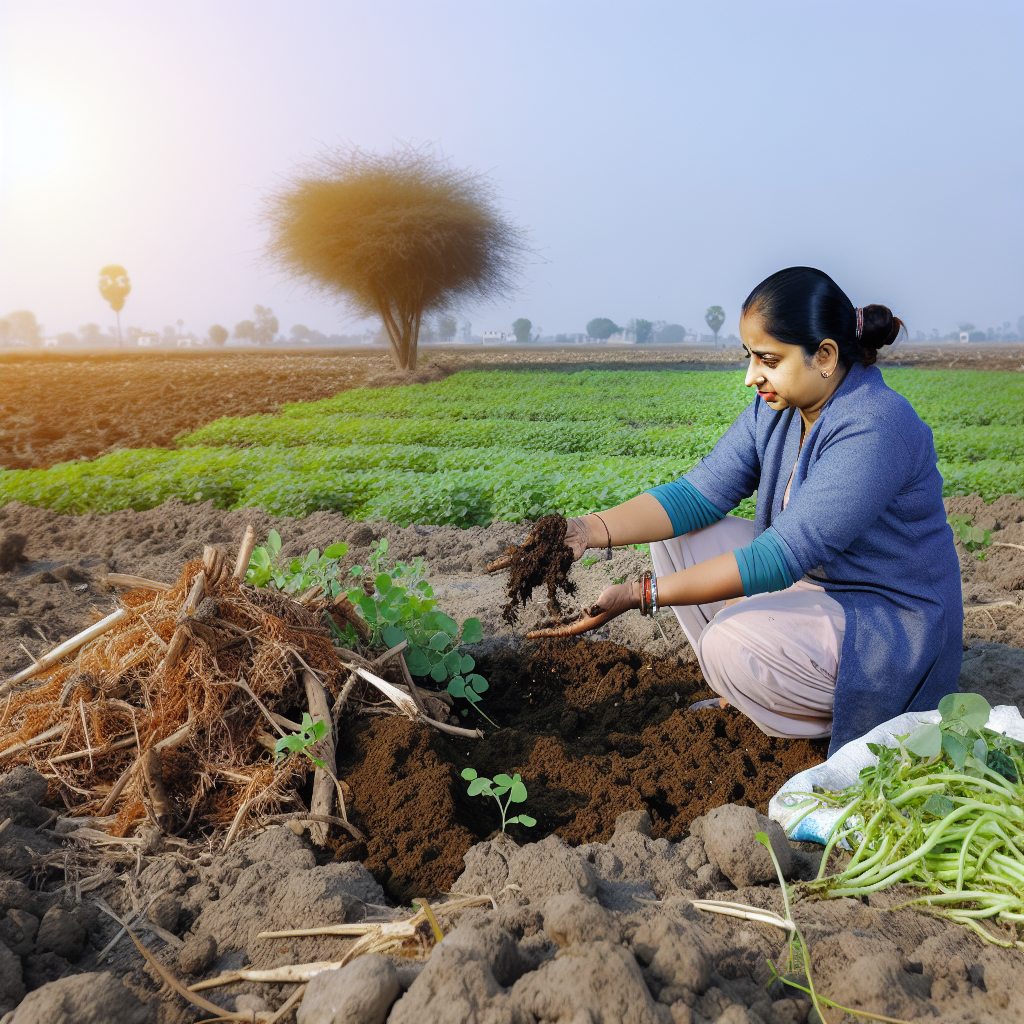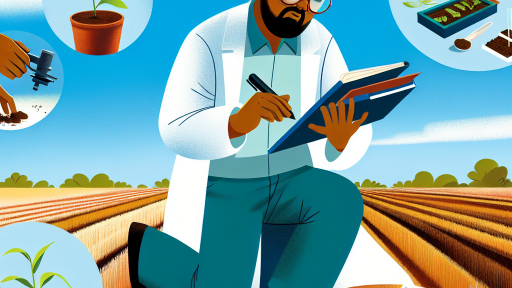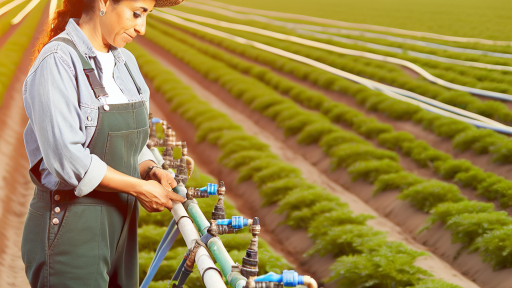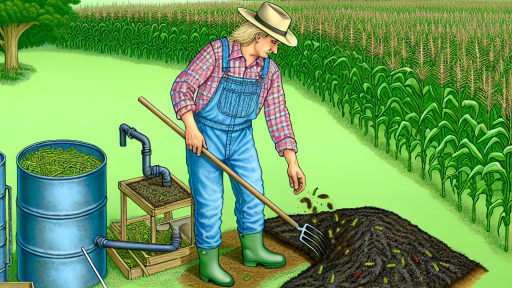Introduction to Cover Crops and Their Role in Soil Regeneration
Cover crops play a crucial role in soil regeneration strategies.
Farmers worldwide increasingly recognize their importance.
These crops are planted primarily to cover the soil.
They protect the soil from erosion and nutrient depletion.
By enhancing soil health, cover crops promote sustainable farming practices.
Types of Cover Crops
Different types of cover crops serve various purposes.
- Cereal grains such as rye and oats prevent soil erosion.
- Legumes, like clover and vetch, fix nitrogen in the soil.
- Broadleaf crops improve organic matter content.
Each type contributes uniquely to soil health.
Farmers select cover crops based on their specific needs.
Benefits of Cover Crops
Cover crops provide multiple benefits for soil regeneration.
- They enhance soil structure and porosity.
- Increased organic matter improves water retention.
- Cover crops suppress weeds naturally.
These benefits lead to healthier ecosystems and improved crop yields.
Implementing Cover Cropping Systems
Farmers must consider several factors for successful cover cropping.
Choosing the right timing is essential for effective growth.
Additionally, soil type and local climate impact crop selection.
Proper management practices ensure that cover crops flourish.
This leads to maximized benefits for soil regeneration.
Transform Your Agribusiness
Unlock your farm's potential with expert advice tailored to your needs. Get actionable steps that drive real results.
Get StartedTypes of Cover Crops and Their Benefits for Soil Health
Introduction to Cover Crops
Cover crops are plants grown primarily to improve soil health.
They provide multiple benefits for agricultural systems.
Farmers use these crops to enhance the sustainability of their soils.
Leguminous Cover Crops
Leguminous cover crops, such as clover and vetch, enhance nitrogen levels in the soil.
These plants fix atmospheric nitrogen, making it available for other crops.
This process reduces the need for synthetic fertilizers.
Additionally, these crops improve soil structure with their extensive root systems.
Common Leguminous Options
- Red clover
- Hairy vetch
- Crimson clover
- Field pea
Cereal Crops
Cereal cover crops, like rye and oats, control soil erosion effectively.
They also prevent weed growth during fallow periods.
These crops develop deep roots, which enhance soil aeration.
Furthermore, they contribute organic matter when tilled back into the soil.
Popular Cereal Choices
- Winter rye
- Oats
- Barley
- Wheat
Brassicas
Brassicas, including radishes and mustards, are crucial for soil regeneration.
They effectively break up compacted soils with their deep tap roots.
These plants also help control pests and diseases in the soil.
Their biomass adds vital organic matter to the soil ecosystem.
Key Brassica Varieties
- Daikon radish
- Mustard
- Rapeseed
Benefits of Cover Crops
Cover crops offer numerous benefits that support soil health and biodiversity.
They improve soil fertility by adding nutrients and organic matter.
Moreover, they enhance soil structure and water retention.
Cover crops also create habitats for beneficial organisms.
Enhanced Soil Properties
- Improved nutrient availability
- Increased soil moisture retention
- Enhanced microbial activity
- Reduced soil compaction
Cover Crops in Sustainable Farming
Incorporating cover crops is vital for sustainable agricultural practices.
They reduce reliance on chemical inputs and promote ecological balance.
Furthermore, these crops help farmers adapt to changing climate conditions.
By using cover crops, farmers can ensure long-term productivity of their lands.
How to Select Appropriate Cover Crops Based on Climate and Soil Type
Understanding Your Local Climate
Identifying your local climate is essential for selecting cover crops.
Showcase Your Farming Business
Publish your professional farming services profile on our blog for a one-time fee of $200 and reach a dedicated audience of farmers and agribusiness owners.
Publish Your ProfileConsider temperature ranges and precipitation patterns.
Understanding your growing season length helps narrow down options.
Additionally, look at historical weather data for trends.
Assessing Soil Characteristics
Soil type significantly influences the choice of cover crops.
Perform a soil test to analyze pH, texture, and nutrient content.
Sandy soils typically drain quickly, needing different crops than clay soils.
Loamy soils offer a balance and can support a wider variety of crops.
Matching Cover Crops to Climate Zones
Consider cool-season and warm-season categories of crops.
Cool-season crops grow well in northern and temperate climates.
Warm-season crops thrive in southern climates with higher temperatures.
Choose cover crops adapted to your specific climate zone.
Evaluating Specific Crop Characteristics
Focus on the benefits different cover crops offer to the soil.
Legumes enhance nitrogen levels, improving soil fertility.
Brassicas help with pest management and soil structure.
Grasses prevent erosion and suppress weeds effectively.
Consulting Local Agricultural Resources
Your local extension office is a valuable source of information.
They can recommend cover crops suited to your region’s specific conditions.
Engaging with local farmers can provide insights based on practical experience.
Webinars and workshops can also help enhance your understanding.
Trial and Adaptation
Start with small plots to trial your chosen cover crops.
Observe how well they perform under your specific conditions.
Gather data on growth rates and soil improvements.
Adjust your selections based on observed results and feedback.
Find Out More: Native Plant Integration in Agricultural Systems
Best Practices for Planting and Managing Cover Crops
Choosing the Right Cover Crop
Selecting the appropriate cover crop is essential for soil regeneration.
Consider legumes, grasses, or brassicas based on your soil health goals.
Legumes, like clover, fix nitrogen and improve soil fertility.
Grasses, such as rye, enhance soil structure and prevent erosion.
Brassicas, like radish, aid in breaking compacted soil layers.
Timing of Planting
Timing is crucial for cover crop success.
Plant cover crops as soon as summer crops are harvested.
This allows adequate growth before winter dormancy.
Additionally, winter cover crops can prevent soil erosion during the cold months.
Soi1 Preparation
Prepare the soil before planting your cover crops.
Clear debris and aerate the soil to enhance seed-to-soil contact.
Testing soil pH and nutrients helps in tailoring cover crop selection.
Seeding Techniques
Employ effective seeding techniques for optimal growth.
Broadcast seeding offers quick coverage and reduces labor.
Drilling seeds provides better depth control and germination rates.
Ensure proper seed spacing to avoid overcrowding and competition.
Showcase Your Farming Business
Publish your professional farming services profile on our blog for a one-time fee of $200 and reach a dedicated audience of farmers and agribusiness owners.
Publish Your ProfileManaging Growth
Monitor cover crops regularly to promote healthy growth.
Keep an eye out for pests or diseases that may affect plants.
Consider adjusting irrigation to maintain adequate moisture levels.
Termination Strategies
Terminate the cover crops at the right time for maximum benefit.
Timing depends on the crop’s growth stage and your main crop requirements.
Mechanical termination methods include mowing or tilling.
Chemical methods should be used judiciously to minimize environmental impact.
Integrating into Crop Rotation
Incorporate cover crops into your crop rotation schedule.
This can enhance biodiversity and improve soil structure.
Additionally, rotating cover crops can disrupt pest cycles and diseases.
Evaluating Soil Health Improvement
Regularly assess the impact of cover crops on soil health.
Conduct soil tests before and after establishing cover crops.
Look for improvements in organic matter, microbial activity, and nutrient levels.
You Might Also Like: Soil Testing Methods For Better Farm Yields
Integration of Cover Crops in Crop Rotation Systems
Benefits of Cover Crops
Cover crops enhance soil fertility significantly.
They prevent soil erosion and improve water retention.
Moreover, cover crops suppress weeds effectively.
This practice promotes biodiversity in farming systems as well.
Choosing the Right Cover Crops
Farmers should consider the climate and soil type.
Each crop type offers unique benefits for soil health.
For instance, legumes fix nitrogen in the soil.
Grasses, on the other hand, enhance soil structure.
Timing and Management
Proper timing is crucial when integrating cover crops.
Planting should align with the main crop schedules.
Farmers can effectively manage cover crops through tillage.
Additionally, regular monitoring ensures optimal growth.
Integrating Cover Crops with Rotation Plans
Cover crops can be rotated with main crops effectively.
This integration enhances nutrient cycling in the soil.
It also minimizes pest populations by disrupting lifecycles.
An effective rotation plan encourages sustainable practices.
Challenges in Implementation
Farmers often face challenges adopting cover crops.
Cost concerns can hinder initial implementation efforts.
Moreover, there might be a lack of knowledge about management techniques.
Addressing these challenges is essential for successful adoption.
Uncover the Details: Using Biochar To Enhance Soil Fertility

Case Studies: Successful Use of Cover Crops for Soil Regeneration
Introduction to the Case Studies
Cover crops play a vital role in soil regeneration.
They enhance soil structure and fertility.
Additionally, they help in reducing erosion and increasing biodiversity.
Case Study: Green Fields Farm
Located in California, Green Fields Farm adopted cover cropping.
They planted clover and vetch during the off-season.
Showcase Your Farming Business
Publish your professional farming services profile on our blog for a one-time fee of $200 and reach a dedicated audience of farmers and agribusiness owners.
Publish Your ProfileThis practice significantly improved their soil health.
After three years, soil organic matter increased by 25%.
Furthermore, they reported higher crop yields in subsequent seasons.
Benefits Observed
- Improved nitrogen levels in the soil.
- Reduced weed populations.
- Enhanced water retention.
Case Study: Rolling Hills Agriculture
Rolling Hills Agriculture is situated in Nebraska.
They implemented a diverse cover crop mix.
The mix included radishes, peas, and rye.
As a result, they saw decreased soil compaction.
Semi erosions reduced considerably over two cropping seasons.
Key Takeaways
- Increased root biomass improved soil structure.
- Better infiltration rates for rainfall.
- Enhanced resilience against drought conditions.
Case Study: Sunny Meadows Organic Farm
Sunny Meadows Organic Farm in Florida utilized buckwheat as a cover crop.
This practice enhanced pollinator habitats.
Moreover, soil tests indicated a decrease in soil acidity.
Ultimately, this improvement led to better vegetable crop quality.
Achievements
- Improved biodiversity among beneficial insects.
- Increased soil pH levels leading to healthier plants.
- Positive impact on pest management strategies.
Implications of Cover Crop Usage
These case studies highlight the effectiveness of cover crops.
Farmers observed multiple benefits from their use.
Soil health improvements are critical for sustainable agriculture.
Transitioning to cover crops can yield substantial long-term gains.
Uncover the Details: Integrating Crop Diversity into Your Farming Practices
Challenges and Considerations When Implementing Cover Crops
Understanding the Environmental Conditions
Farmers must assess their specific environmental conditions before choosing cover crops.
Soil type, climate, and previous land use impact crop selection.
Additionally, understanding local pest populations helps inform decisions.
Choosing the Right Cover Crops
Selecting appropriate cover crops is crucial for successful implementation.
Different crops serve various purposes, such as nitrogen fixation or erosion control.
Farmers should consider growth habits and compatibility with cash crops.
Consulting local agricultural extension services can provide valuable insights.
Managing Potential Risks
Implementing cover crops comes with potential risks farmers must address.
For example, some cover crops may harbor pests or diseases.
Additionally, cover crops can compete with cash crops for nutrients and water.
Proper planning and management can mitigate these risks substantially.
Economic Considerations
Cost factors play a significant role in the adoption of cover crops.
Initial investment costs can be a barrier for many farmers.
Calculating potential long-term benefits helps justify these initial expenses.
Also, analyzing yield benefits and soil health improvements aids in decision-making.
Education and Training
Knowledge and training are essential for successful cover crop implementation.
Farmers may require workshops or resources to understand new practices.
Networking with other farmers can facilitate knowledge exchange and support.
Utilizing online resources can also enhance understanding of cover crop benefits.
Measuring the Impact of Cover Crops on Soil Regeneration
Importance of Key Indicators
Key indicators measure the effectiveness of cover crops in soil regeneration.
These indicators help farmers assess changes in soil health.
Additionally, they provide insight into how cover crops impact crop yields.
Common Indicators to Consider
- Soil organic matter content
- Soil erosion rates
- Soil compaction levels
- Nutrient availability and cycling
- Biodiversity of soil microorganisms
Methods of Assessment
Farmers can use various methods to assess these indicators.
Showcase Your Farming Business
Publish your professional farming services profile on our blog for a one-time fee of $200 and reach a dedicated audience of farmers and agribusiness owners.
Publish Your ProfileSoil testing provides quantitative data on organic matter levels.
Visual assessments help observe soil structure and erosion patterns.
Field experiments can track changes over multiple growing seasons.
Utilizing Soil Testing Services
Many agricultural extension services offer soil testing.
These services analyze soil samples for key nutrients and health indicators.
Farmers can receive tailored recommendations based on test results.
Monitoring Soil Health Over Time
Long-term monitoring is essential for assessing soil regeneration.
Farmers should track changes annually to observe trends and improvements.
Regular assessments can help identify successful cover crop strategies.
Gathering Data from Research Studies
Research studies provide valuable insights into cover crop impacts.
Farmers can participate in local agronomy trials for hands-on experience.
Additionally, collaborating with universities can enhance understanding.
Additional Resources
Soil Health | Natural Resources Conservation Service
Influence of cover crops at the four spheres: A review of ecosystem …




